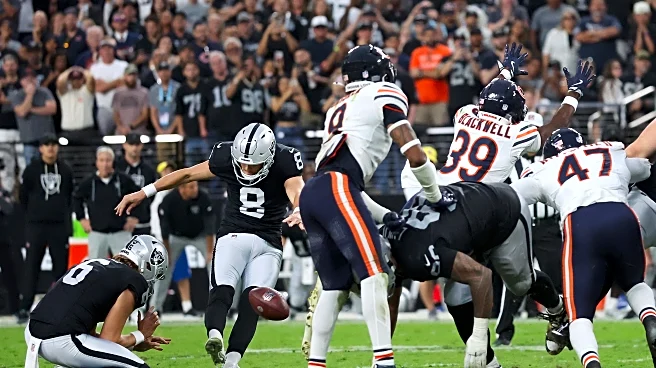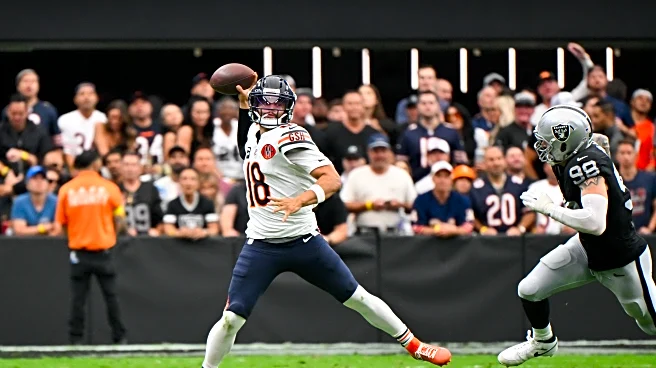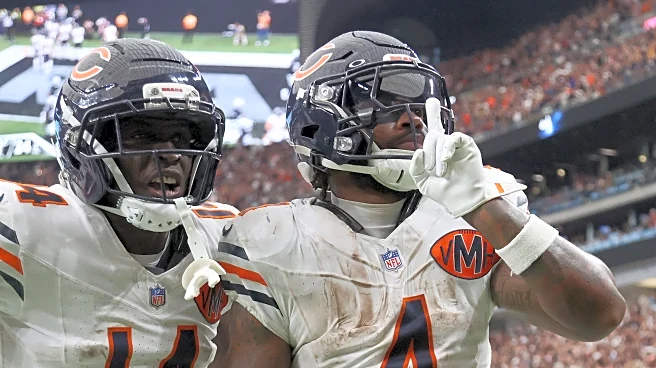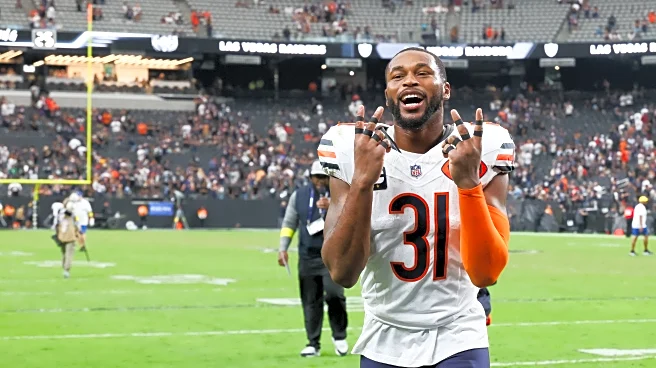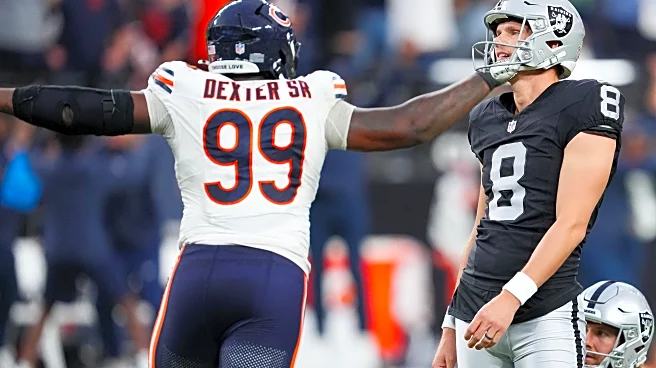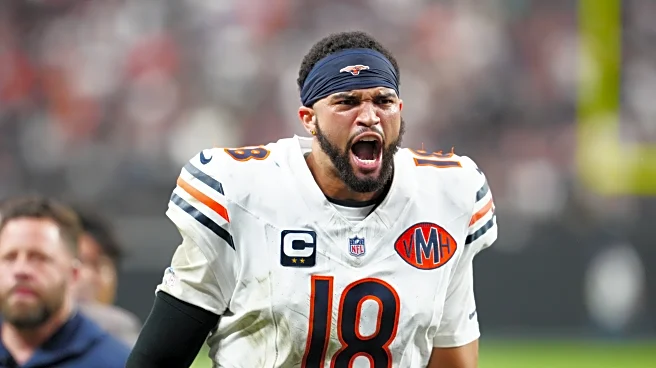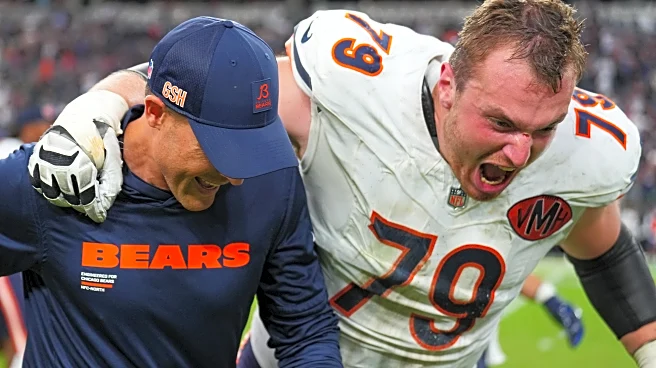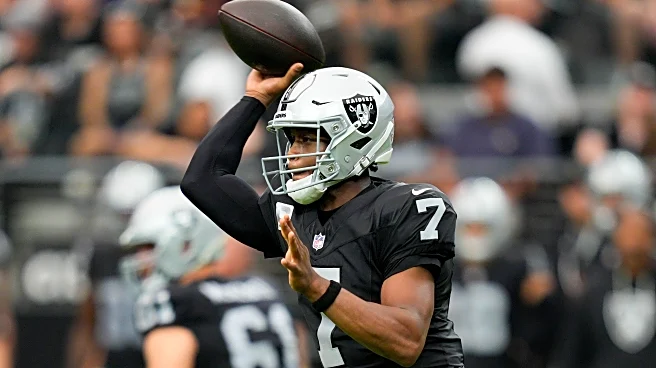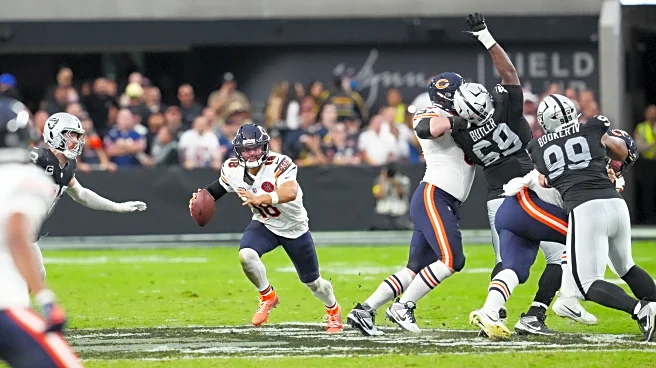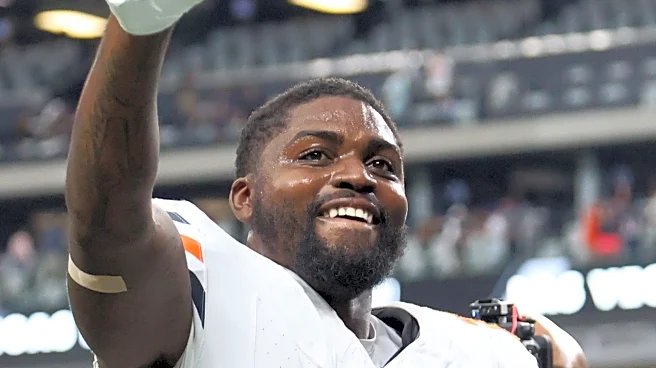The NFL doesn’t track style points—just wins. And on that note, the Chicago Bears channeled a little Al Davis “Just win, Baby” energy this week, leaving Las Vegas as a .500 ballclub heading into their
Week 5 bye.
The league is filled with parity — which is a polite way of saying mediocrity. Through four weeks, 58% of games have been one-possession wins. Despite their inability to stop the run, or run the ball, or turn plus-territory possessions into touchdowns, the Bears battled for 60 minutes and in the end each phase played a role in the 25-24 victory.
Diving into the data
Let’s look at some numbers from Sunday’s game that both tell the tale of the game, but additionally show trends — good and bad — about the state of the beloved.
- Five of the Bears’ 10 offensive possessions made it inside the Raiders’ 25-yard line. Three of those five started at the 24, 20 and 24 respectively — two off of turnovers generated by the defense — yet the Bears only came away with just six points. On one of those three drives, the Bears ended up losing 16 yards and punting from the Raiders’ 40-yard line, resulting in a touchback. Good teams don’t squander that many opportunities.
- Speaking of turnovers, the Bears’ defense generated four takeaways for the second-straight week, bringing their season total up to nine, which ranks third-best in the league, as does their plus-five turnover margin. A lot of credit needs to be given to defensive backs coach Al Harris, who was a gambler himself as a player. The defensive backs are clearly recognizing patterns based on formation and down-and-distance and their coaching and scouting is paying off. Kevin Byard was outstanding all game and he hawked Raiders quarterback Geno Smith twice on an in-breaker from the slot. Tyrique Stephenson was Johnny-on-the-spot with a fumble recovery, but also had an incredible diving interception from a trail technique on a crosser. Stephenson has been outstanding in back-to-back games.
- The Raiders averaged an eye-popping 7.7 yards per rush attempt and nine explosive (carry of 10-plus) rushes on 31 attempts. For the season, the Bears’ defense is giving up a league-worst 6.1 yards per rush attempt, and the 658 rushing yards they’ve given up rank dead last in the league. The defensive line is consistently losing at the line of scrimmage and teams are making it to the second level cleanly far too often and easily.
- The Bears didn’t register a sack against the Raiders. Through four games this season, they’ve generated just five sacks and their pressure rate of 20.7% ranks 29th in the league. Considering the investments they’ve made across the defensive line, this is a sub-optimal return and a concerning trend. Yes, Kyler Gordon’s return will help the slot-corner blitz package. But relying on a coverage player to generate heat in the pass rush isn’t a sustainable plan.
- Rome Odunze caught his fifth touchdown pass of the season (I’ll break that laser beam down below). Considering he has 20 catches on the season, he’s providing elite efficiency as a weapon in plus territory and is fearless on in-breaking routes in traffic. The Bears have a budding blue-chip player on their roster, a homegrown one at that.
- The Bears’ defense allowed the Raiders to convert just two of their eight third downs. For the season, they rank first in the league in opponent third-down conversion percentage (12 out of 41, equaling 29.3%). Even with a struggling pass rush Dennis Allen’s crew is getting it done on money downs.
- The Bears’ offense converted seven of 16 third downs. For the season, they rank fourth in third-down conversion rate (25 out of 55, equaling 45.45%).
- The Bears racked up eight penalties for 60 yards against the Raiders. That brings their season total to 34 penalties costing them 278 yards, the fourth- and seventh-highest numbers respectively in the league.
Game notes
One individual performance that should be noted was that of swing tackle Theo Benedet. He started the game at right tackle and, yes, he had a rough start against All-World defensive end and overall game wrecker Maxx Crosby. But Benedet is not unique in that regard. He couldn’t match Crosby’s energy and relentlessness and will learn to take rib shots when defensive linemen jump to bat passes — punish jumpers! — but he battled and settled in.
The Bears tried myriad ways to counter the pressure Crosby was generating. They ran screens, they ran zone-read (bad read by Caleb Williams on that call, should have been an automatic give to the running back), began chipping and sifting with their tight ends, but the best plan was eventually to just run away from Crosby. What’s this have to do with Benedet?
Not only did Benedet have to play on the right side, he switched over to the left side late in the second quarter replacing Braxton Jones, which could be more than just for this game. He looked much better on the left side. Benedet was up-and-down in pass protection, but he was strong in the run game. He has a tendency to lunge and can get off balance. But on a team looking for answers at left tackle, let’s see what he can do with a bye week and an extra week to prep.
With Benedet moving to left, the Bears got a look at rookie Ozzy Trapilo on the right side. Trapilo’s footwork needs work and he showed a tendency to bend from his waist instead of sinking his hips and knees. But live reps against someone like Crosby — whom the Bears helped out with tight ends and backs, and even brought Joe Thuney over on a pass set — is valuable for the rookie and team to see where he’s at in his development.
Finally, let’s appreciate all three phases being nails when it mattered most at the end of the game. To start, the Bears’ defense allowed the Raiders to get inside the 10-yard line on their second-to-last drive of the game. The Raiders had the ball first-and-goal from the seven, yet the Bears defense was able to drop Ashton Jeanty for negative runs on first and second down, and an incompletion on third. This set up a field goal, that made the it a five-point game 24-19.
Next the offense took possession with 6:39 left in the game and drove 69 yards in five minutes, capping it with a D’Andre Swift touchdown to make the game 25-24. The two-point play was sniffed out, leaving it a one-point game with 1:34 remaining.
The special teams allowed a long return of 38 yards setting the Raiders up with ideal field position at their 42-yard line. Five plays later, they reached the Bears’ 35-yard line setting up a 54-yard attempt by Daniel Carlson. A scouting tip by long snapper Scott Daly to the field-goal-block team indicated Raiders long snapper Jacob Bobenmoyer twisted the ball before snapping. This piece of intel gave Josh Blackwell the key he needed to get the jump on the snap and his hand on the ball to secure the win.
That sequence is the definition of complementary football.
Film time
Let’s look at the laser beam Williams threw to Odunze in the third quarter.
On their first possession of the second half, the Bears have the ball 3rd-and-12 from the Raiders’ 27 yard line. The Bears break the huddle in 11 personnel (one running back, one tight end and three receivers) in a condensed two-by-two set.
The Raiders are showing pre-snap pressure in a double-A gap “mug” look with seven defenders crowding the line of scrimmage.

The route concept has D.J. Moore running a post and Odunze running a deep in cut underneath the deep defenders. Underneath, Olamide Zaccheaus and Swift run a mesh concept.

The Raiders end up sending six and dropping five in a Cover-4 zone look. The two deep safeties are anticipating the pressure getting home, so they’re lurking underneath expecting a throw underneath. But Williams is eyeing Odunze from the snap.

What impressed me most about this throw was two-fold. First off, the anticipation Williams showed on this throw. Check out where Odunze is in his route as Caleb is releasing the ball. He hasn’t even made his in cut as Caleb is releasing the ball.

Secondly, amid a collapsing pocket, Williams keeps his cool and delivers a 25-yard dart on a line to Odunze’s face for the touchdown.


More, please.
Parting thoughts
This was exactly the type of game the Bears would have lost last season. But they didn’t. They found a way. Hopefully, this is a sign of the culture change being led by head coach Ben Johnson and his staff.
Players typically prefer byes later in the season. But given where this team is at both from a health and overall identity standpoint, the timing might be great. Head to the bye knowing you didn’t play your best, but still won a game on the road. Now it’s time to self-scout tendencies, reassess individual player performances, and become the team that just doesn’t survive Sundays, but starts to shape them.

